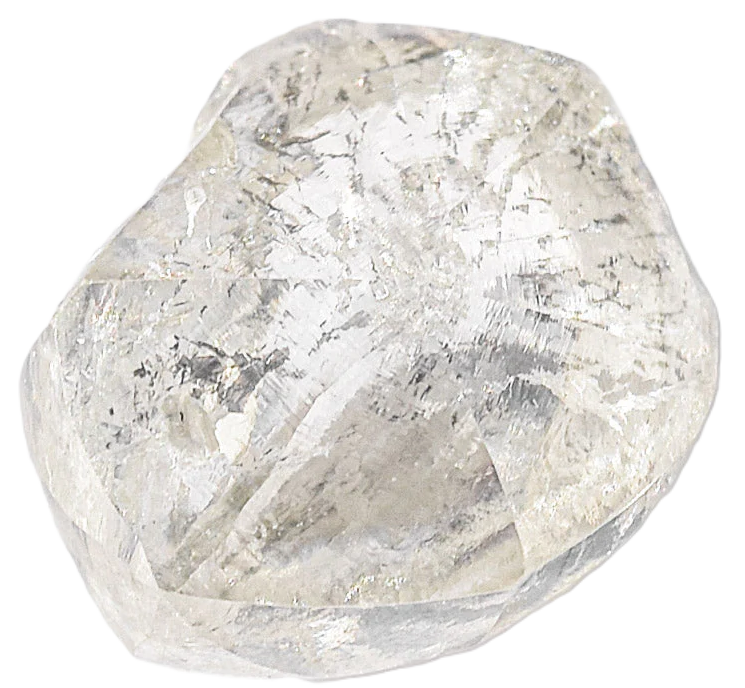
The word diamond derives from the Greek adámas, meaning “unconquerable” or “indestructible”, reflecting its legendary hardness. Throughout history, diamonds have also been called the Stone of Invincibility. In Sanskrit, it is known as vajra, meaning thunderbolt, a symbol of spiritual power. Alternate names include the King of Gems and, poetically, Tears of the Gods.
Composition, Physical Characteristics, and Varieties
Diamonds are composed of pure carbon, crystallised in a cubic structure under immense heat and pressure deep within the Earth’s mantle. They are the hardest known natural substance, rated 10 on the Mohs scale, with unparalleled brilliance and fire due to their refractive index. While most diamonds appear colourless, they can be found in hues such as yellow, pink, blue, green, red, and black, known as fancy diamonds. Each variety owes its colouring to trace elements or structural irregularities—for example, boron creates blue diamonds, while nitrogen gives a yellow tint.
Geographical Locations
Diamonds are found across the globe, with major deposits in South Africa, Botswana, Namibia, Angola, Russia, Canada, and Australia. Historically, India’s Golconda mines supplied some of the world’s most legendary diamonds, including the Koh-i-Noor. Today, Russia and Botswana remain among the leading producers, while Canada has emerged as a significant source of high-quality stones.
Archaeological and Significant Finds
Diamonds have been known and cherished for over 3,000 years. Ancient India was the first known source, where they were used in religious icons and traded along the Silk Road. Some of the most famous diamonds include the Koh-i-Noor, the Cullinan Diamond (the largest gem-quality diamond ever found, cut into stones adorning the British Crown Jewels), and the Hope Diamond, famed for its alleged curse. In modern times, diamonds remain highly prized for both jewellery and industrial applications due to their exceptional hardness.
Historical and Current Usage
Historically, diamonds symbolised invincibility and divine favour, often set into royal crowns and weapons. Today, they are most recognised as the ultimate symbol of love and commitment, especially in engagement and wedding rings. Beyond adornment, diamonds are used in cutting, drilling, and polishing industries, where their durability proves essential.
Interesting Facts
- Diamonds form around 150–200 kilometres below the Earth’s surface and are brought up by volcanic eruptions through kimberlite pipes.
- The Cullinan Diamond weighed over 3,100 carats before being cut.
- Natural red diamonds are the rarest, with only a handful ever discovered.
- Lab-grown diamonds, identical in composition to natural ones, are becoming increasingly popular.
Folklore, Superstition, Legends, and Tales
Diamonds have long been surrounded by myths and legends. Ancient Greeks believed they were the tears of the gods or fragments of fallen stars. In Indian mythology, diamonds were said to ward off evil and bring good fortune. Medieval warriors wore them for protection in battle, believing the stones conferred strength and courage. The Hope Diamond, by contrast, is steeped in tales of misfortune and tragedy for its owners, adding to its mysterious allure.
Mystical Healing Properties
Diamonds are regarded as stones of clarity, strength, and energy amplification. They are said to:
- Enhance inner strength and resilience.
- Purify the aura, dispelling negativity.
- Stimulate creativity and imagination.
- Promote harmony in relationships.
- Boost spiritual growth and awareness.
Astrology and Zodiac Links
In astrology, the diamond is strongly linked with Venus, the planet of love, beauty, and harmony. It is particularly associated with Taurus and Libra, enhancing their natural charm, loyalty, and sense of balance. Diamonds are also considered beneficial for Aries and Leo, offering clarity and courage.
Chakra Connections
Diamonds are linked to the Crown Chakra, the energy centre of enlightenment, connection to higher consciousness, and spiritual awakening. They are believed to open the mind to divine light, promote unity with the universe, and amplify the energy of other crystals when used together.
Birthstone and Wedding Anniversary
Diamond is the birthstone for April, symbolising eternal love, strength, and purity. It is also the traditional gift for the 60th wedding anniversary, known as the Diamond Jubilee, representing enduring strength and resilience in marriage.
Crystal Combinations: What Works and What to Avoid
Diamonds amplify the energies of other crystals, making them powerful allies in healing grids. They pair well with clear quartz for clarity, rose quartz for love, and sapphire for wisdom. However, care should be taken when combining them with overly intense stones such as obsidian or hematite, as the amplification may become overwhelming and energetically unbalanced.
